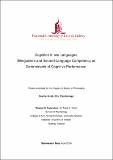| dc.description.abstract | Introduction. This project emphasises the importance of two aspects in research on bilingualism: (i) the inclusion of multiple language sets to reach generalisable results, which ensures that differences originate in changes due to bilingualism rather than the specific effect of certain language sets implemented, and (ii) the comparison of a bilingual individual’s performance in first and second language for a deeper insight into the influence of bilingualism on cognition. This is best achieved through the implementation of verbally-based measures focusing on higher cognition, such as tasks assessing critical thinking.
Methods. Participants of nine different language sets were presented with the critical thinking assessment Mixed Measures, a compilation of published measures covering five subcategories of critical thinking: hypothesis testing, verbal reasoning, judging likelihood and probability, argumentation analysis, and problem solving. Socioeconomic status and language experience and proficiency were measured, as well as a number of Raven’s Standard Progressive Matrices which were implemented to control for fluid intelligence. Outcomes of mono- and bilingual individuals were compared, as well as the performance of bilingual individuals in first and second language.
Results. Comparative calculations of monolingual and bilingual individuals were not found to be consistent across language groups. Differences were discovered within four of the nine language groups, with an advantage of bilingual participants in three of these four groups. Due to the lack of consistency throughout all groups, these findings were not conclusive. When comparing bilinguals’ first and second language, two findings stood out: an advantage of solving verbal reasoning scenarios in the first language, whereas questions assessing judging likelihood and probability were solved better in the second language.
Conclusions. Higher exposure to the first language could explain advantages within verbal reasoning, whereas a certain emotional detachment might explain advantages when solving judging likelihood and probability measures in the second language. | en_IE |


